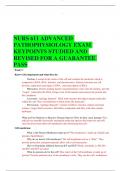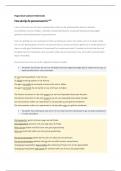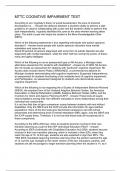-
1. Examen - Family nurse practitioner test verified solutions 2023//2024
-
2. Examen - Family nurse practitioner test verified solutions 2023//2024
-
3. Examen - Nursing care of children/maternal newborn capstone 100% solved solutions test que...
-
4. Examen - Rn nursing care of children: cystic fibrosis inpatient care verified 100% solutio...
-
5. Examen - Ati- pre assessment nursing care of children 100% solutions test questions
-
6. Examen - Ati nursing care of children proctored exam 100% solutions test questions
-
7. Examen - Rn nursing care of children 1 100% solutions test questions
-
8. Examen - Ati rn nursing care of 100% solutions test questions
-
9. Examen - Nurs exam
-
10. Examen - Nurs 6531
-
11. Examen - Nurs final exam 100% verified solutions 2023//2024
-
12. Examen - Nurs620 exam 100% verified solutions 2023//2024
-
13. Examen - Nurs 5220 test 2 exam 100% verified solutions
-
14. Examen - Nurs 652-- module 1- 2: think like an fnp &heent 100% solutions
-
15. Examen - Chapter 38: nursing care of a family when a child needs medication administration o...
-
16. Examen - Nurs 629 exam 3 (maryville) verified 100% solutions
-
17. Examen - Nurs 629 exam verified 100% solutions
-
18. Examen - Nurs 629 exam 3 (maryville) verified 100% solutions
-
19. Examen - Nurs 629 exam 2 solutions 100% correct answers
-
20. Examen - Nurs 629 exam solutions 100% correct answers
-
21. Examen - Nurs629 exam 2 solutions 100% correct answer
-
22. Examen - Edapt - pediatric nursing - nr328 - tonsillitis case study solutions
-
23. Examen - Nurs 251 final test 100% verified solutions 2023/2024
-
24. Examen - Nurs 1400: mhealth test solutions 100% correct answers
-
25. Examen - Nurs232 – pharmacology 100% verified test solutions 2023/2024
-
26. Examen - Exam (elaborations) nursing peds
-
27. Examen - Exam (elaborations) nursing
-
28. Examen - Exam (elaborations) cna - certified nursing assistant
-
29. Examen - Exam (elaborations) cna - certified nursing assistant
-
30. Examen - Exam (elaborations) cna - certified nursing assistant
-
31. Examen - Exam (elaborations) nursing=genetics
-
32. Examen - Exam (elaborations) cna - certified nursing assistant
-
33. Examen - Nursing midterm 100% verified solutions
-
34. Examen - Exam (elaborations) apn - advanced practice nurse
-
35. Examen - Nrnp 6552 / advanced nurse practice /reproductive health care walden university midt...
-
36. Examen - Nurse aide written exam (cna) real exam 2 100% verified solutions latest versions ...
-
37. Examen - Certified nursing assistant final exam latest update for versions 1.2.3 20232024 10...
-
38. Examen - Nurse aide written exam (cna) real exam 2 100% verified solutions latest versions ...
-
39. Examen - Nrnp 6552 advanced nurse practise in reproductiv e health care questions and v...
-
40. Cas - Nursing 595 versions with 100% complete verifie solutions latest update 2023-2024
-
41. Examen - Nurs 176 exam question with verified correct answers latest update 2023
-
42. Examen - Wgu d220 nursing informatics real exam questions with answers 2023
-
43. Examen - Nurs 6550 final exam questions and verified answers latest update 2023
-
44. Examen - Nr302 final comprehensive exam questions and answers latest update 2023-2024 cham...
-
45. Examen - Nr507 advanced pathophysiology midterm exam latest update 2023-2024 chamberl...
-
46. Examen - Nr 511 midterm exam complete 100% questions and correct answers latest update 2023/2...
-
47. Examen - Nr 293 ati pharmacology final exam latest versions 2023/2024 200+ questions and...
-
48. Examen - Nurs 602 real final exam (4 different versions) with questions and correct answe...
-
49. Examen - Nurs 6512 real final exam questions and correct answers latest update 2023/2024
-
50. Examen - Nurs 6512 real final exam questions and correct answers latest update 2023/2024 ...
-
51. Examen - Nurs 6512 final exam questions and correct answers latest update 2023-2024 walden...
-
52. Examen - Nurs 6512 3 different versions midterm exam questions and correct answers lates...
-
53. Examen - Nurs 6512 version 1 midterm exam questions and correct answers latest update 2023...
-
54. Examen - Nurs 6512 real final exam questions and correct answers latest update 2023-2024...
-
55. Examen - Nurs 6501 advanced pathophysiology midterm exam questions with verified answers ...
-
56. Examen - Nurs 6501 - advanced pathophysiology form a final exam questions with 100% correct ...
-
57. Examen - Nurs 6501 final exam questions and answers latest update 2023-2024
-
58. Examen - Nurs 6501 - advanced pathophysiology form c final exam questions with 100% correct ...
-
59. Examen - Nrnp6552 advanced nurse practice in reproductive health care midterm exam ques...
-
60. Examen - Essentials of maternity newborn and women's health nursing 5th edition ricci tes...
-
61. Examen - Nclex - nursing jurisprudence: legal and ethical considerations nclex practice quiz...
-
62. Examen - Nurs 6501 advanced pathophysiology midterm latest 2023- 2024 exam
-
63. Examen - Nurs 5366 module 5 questions with answers latest update 2023- 2024
-
64. Examen - Ati nursing care of children proctored exam combined /complete guid for exam prepar...
-
65. Examen - Nurs 6512 midterm advanced health assessment exam latest 2023/2024
-
66. Examen - Nurs 6512 midterm advanced health assessment exam latest 2023/2024
-
67. Examen - Nurs 6502 advanced pathophysiology questions and correct 100% answers latest upd...
-
68. Examen - Nurs 6502 advanced pathophysiology midterm exam latest update 2023
-
69. Examen - Nurs 251 pharmacology final exam 2023/2024
-
70. Examen - Hsco 502 test 1/nurs 502 final exam latest update 2023-2024
-
71. Examen - Nurs 615 pharm exam 1 questions and correct answers latest update 2023/2024
-
72. Examen - Nurs 6521 advanced pharmacology final exam questions with correct answers latest upd...
-
73. Examen - Nurs -6501 advanced pathophysiol ogy exam latest update 2023/2024
-
74. Examen - Nursing questions and answers latest update 2023/2024
-
75. Examen - Nur 2811 nursing capstone online exam questions with correct answers latest update...
-
76. Examen - Nur 2811 nursing capstone questions and correct answers
-
77. Examen - Nursing newborn exam questions and answers 2023
-
78. Examen - Nur2459 mental and behaviour/ health nursing real exam questions and correct answ...
-
79. Examen - Nurs 1660 exam questions and answers latest update 2023/2024
-
80. Examen - Nur2459 mental and behaviour/ health nursing real exam questions and correct answ...
-
81. Examen - Boards of nursing vs. professional nurse associations
-
82. Examen - Nursing/ pharmacology hesi question & answers testbank 2023/2024
-
83. Examen - Hondros nursing 185 exam questions with correct answers 2023
-
84. Examen - Nurs611 maryville university: patho q&a verified and already passed withrationales
-
85. Examen - Nurs 611 patho maryville exam 3 q&a verified
-
86. Examen - Pediatric ati / pediatric nursing exam real question with answers and rationales o...
-
87. Examen - Ati rn nursing care of children real exam tests 600 questions with verified answers...
-
88. Examen - Nurs-6501n-43--module 2 knowledge check test-- advanced pathophysiology questions wit...
-
89. Examen - Nurs 611 advanced pathophysiology exam keypoints studied and revised for a guarant...
-
90. Examen - Nurs 6501 /advanced pathophysiology latest exam guaranteed pass(a+)
-
91. Examen - Test bank for professional nursing concepts & challenges 9th edition all chapters c...
-
92. Examen - Test bank medical – surgical nursing in canada 4 th edition lewi all chapters cov...
-
93. Examen - Test bank introduction to critical care nursing 8th edition :(sole klein moseley) q...
-
94. Examen - Test bank maternal newborn nursing /critical components of nursing care by, roberta...
-
95. Examen - Test bank for maternal child nursing care 7th edition byshannon e. perry, marilyn j....
-
96. Examen - Test bank for health assessment for nursing practice 7th edition / wilson exam rea...
-
97. Examen - Test bank for introductory medical�surgical nursing practice real exam questions wit...
-
98. Examen - Test bank for wong’s essentials of pediatric nursing 11th edition by hocken berry...
-
99. Examen - Neebs-mental –health- nursing 5 th edition by gorman real reviewed exam question...
-
100. Examen - Test bank for leadership roles & management functions in nursing 10th edition by ma...
-
101. Examen - Test bank for leadership roles and management functions and nursing 10th edition b...
-
102. Examen - Test bank for leadership roles and management functions in nursing 10th edition marq...
-
103. Examen - I human study case heart failure home health reasoning ½ first home health nurse v...
-
104. Examen - Interpersonal relationship professional communication skills for nurses 8th edition ...
-
105. Examen - Test bank for davis advantage for psychiatric mental health nursing 10th edition by...
-
106. Examen - Test bank –leadership roles and management functions in nursing theory and applic...
-
107. Examen - Test bank for foundations of maternal newborn and womens health nursing 8th edition ...
-
108. Examen - Test bank success in practical vocational nursing student to leader, 10th edition ...
-
109. Examen - Nurs 5315 advanced pathophysiology uta exam questions with verified answers latest...
-
110. Examen - Nurs 5315 uta test questions answered correctly
-
111. Examen - Nurs 5315- renal disorders test 4 questions with verified answers 100%
-
112. Examen - Nurs 5315- renal disorders test 4 questions with verified answers 100%
-
113. Examen - Nurs 5315 - disorders of the gi system test 4 -blue print real exam questions & ver...
-
114. Resume - Nurs 221 exam 1 reviewed questions and answers |guaranteed pass latest update
-
115. Examen - Community health nursing real exam questions with verfied answers
-
116. Examen - Hondros nurse 150 final verified questions & correct answers | latests update
-
117. Examen - Pharmacology- nurs 251 module exam 6 portage complete set questions & answers | upd...
-
118. Examen - Nurs 6501 structure and function of the renal and urologic systems prep test questi...
-
119. Examen - Nurs 663 test 4 questions and answers 2023
-
120. Examen - Nurs 663 test 1 questions & answers
-
121. Examen - Maryville nurs 663 exam 2 questions and answers 2023
-
122. Examen - Maryville nurs 663 exam 3 combined tests
-
123. Examen - Nurs 663 - exam 1 questions & verified answers latest updates
-
124. Examen - Nurs 663 maryville psych exam 3 questions with verifed answers latest updates
-
125. Examen - Maryville nurs663 exam 2 actual exam test questions
-
126. Examen - Nurs 663 exam 2 prep test questions with answers verified
-
127. Examen - Nurs 663 test questions with verified solutions 100%
-
128. Examen - Maryville university nurs 663 piaget's cognitive development prep test q&a
-
129. Examen - Nurs 663- exam 1 test questions with verified solutions 100%
-
130. Examen - Nurs 8022 exam 1 questions with correct answers 100%
-
131. Examen - Ut tyler fnp nurs 5350 adv patho exam 1 questions with verified expert solutions | ...
-
132. Examen - Maryville nurs 615 pharm exam 2 exam questions with correct verified answers
-
133. Examen - Maryville nurs 615 pharm exam 1 actual exam test questions with correct verified an...
-
134. Examen - Chapter 01: mental health and mental illness halter: varcarolis’ foundations of psy...
-
135. Examen - Test bank varcarolis' foundations of psychiatric-mental health nursing a clinical9 t...
-
136. Examen - Cardiology nursing 1 humber final exam questions and correct detailed answers with di...
-
137. Examen - Test bank for health assessment for nursing practice 7th edition by susan/ foret /...
-
138. Examen - Hesi exit family nurse practitioner & advanced practice registered nurse {aprn} fi...
-
139. Examen - Hesi health assessment nursing rn v1 real exam questions with verified 100 % correc...
-
140. Examen - Nrnp 6552midterm exam /nrnp6552 midterm advanced nurse practice in reproductive heal...
-
141. Examen - Maternal newborn nursing ati real exam questions and answers | verified
-
142. Examen - Nr 326 cms exam real questions and 100 % verified correct answers what is nurse joh...
-
143. Examen - Nr 599 nursing & informatics real questions and 100 % verified correct answers | la...
-
144. Examen - Nr 599 nursing & informatics 2023 exam questions and 100 % verified correct answers |...
-
145. Examen - Nr302 final comprehensive exam questions and 100 % verified correct answers | latest...
-
146. Examen - Nr 326 exam questions and 100 % verified correct answers with rationale | latest u...
-
147. Examen - Nr507 advanced pathophysiology exam questions and 100 % verified correct answers wi...
-
148. Examen - Nurs 6521 finals 3 different versions verified questions with verified expert solu...
-
149. Examen - Nurs 6630n final exam verified questions with 100% expert solutions
-
150. Examen - Nurs-6630a-2/nurs-6630n�2/nurs-6630d-2/nurs-6630c-2- combined exam questions with co...
-
151. Examen - Nurs 6630n final exam latest update| actual questions with verified answers
-
152. Examen - Nurs 6630n complete set exam questons and correct answers with rationale
-
153. Examen - Nurs 190 physical assessment final exam questions with verified correct answers | l...
-
154. Examen - Nurs 6630 actual exam questions with verified correct answers| latest update
-
155. Examen - Nurs-6501 case study for a {76- year old female patient complains of weight gain, sho...
-
156. Examen - Nurs 6501 final exam questions with verified correct answers | latest update
-
157. Examen - Nurs 6521 advanced pharmacology final actual exam questions with verified correct ...
-
158. Examen - Nurs 6502 advanced pathophysiology actual real questions with verified solutions 1...
-
159. Examen - Nurs6512 advanced health assessment questions with verified correct answers | late...
-
160. Examen - Nurs 6521 midterm examquestions and verified answers latest update
-
161. Examen - Nurs 6521 advanced pharmacology final actual exam questions with verified correct ...
-
162. Examen - Nursing msn 571 pharm - final exam questions with verified correct answers | latest...
-
163. Examen - Ati nursing care of children proctored exam questions and correct answers with ratio...
-
164. Examen - Ati nursing care of children proctored exam latest update 300+ exam questions and ve...
-
165. Examen - Test bank - gerontologic nursing, 6th edition (meiner, 2019), chapter 1- 29 | all c...
-
166. Examen - Nr599 final exam (updated complete solutions, already graded a) chamberlain college...
-
167. Examen - Nr 222 exam with (2 latest versions 2023) health and wellness|complete 100+ questions...
-
168. Examen - Nr293: final exam latest 2023-2024 questions and correct answers latest update good l...
-
169. Examen - Nr 293 ati pharmacology final exam 200+ questions and correct answers|agrade|chamber...
-
170. Examen - Nr302 exam questions with verified answers latest update 2023-2024 chamberlain coll...
-
171. Examen - Nr341 complex adult health exam questions with verified solutions | pass guarantee w...
-
172. Examen - Nr503 final exam / nr 503 epidemiology | actual exam questions & correct answers c...
-
Montrer plus






